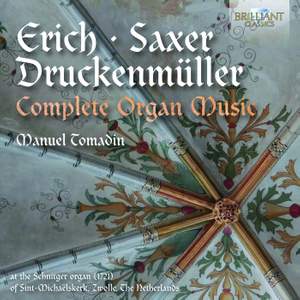While J.S. Bach, along with Buxtehude, has long been considered the father of Baroque organ music in northern Germany, organ music connoisseurs today have started to look beyond the established canon of this time to the great composer’s contemporaries. Particularly interesting are three German composers who were also active around the same time as Bach: Erich, Saxer and Druckenmüller, whose complete works (as discovered in manuscript form) feature on this release.
All three were unusual in that they came from provincial areas of Germany rather than being based in a thriving cultural centre like Hamburg or Lübeck. Druckenmüller – just two years younger than Bach – was highly unusual in publishing completely original Concertos for organ solo, in contrast to Bach’s settings of established chorale tunes that were the norm. The Concertos – all fast–slow–fast – are written in the style that was fast becoming the established one in Germany, the Italian Style. Slightly younger was Georg Saxer, whose style was starting to reflect the new galant Rococo. His Preludes, followed by a long Fugue, reflect new tensions with dominant seventh chords that seem to hang in the air, creating moments of suspense. Daniel Erich – more of Buxtehude’s time than Bach’s – wrote chorale preludes, of which only four survive. They reveal a composer full of expressivity and elegance in the way he embellishes the theme, whether in the soprano or the pedal. His original compositions show a remarkable originality as well as knowledge of the idiomatic writing of the time.
Italian organist Manuel Tomadin’s passion for these undiscovered composers comes across clearly in this release. He has specially chosen a Baroque organ by Arp Schnitger, the most important organ builder of the period, who worked closely with both Saxer and Druckenmüller during his life, making this a wonderfully authentic recording.



